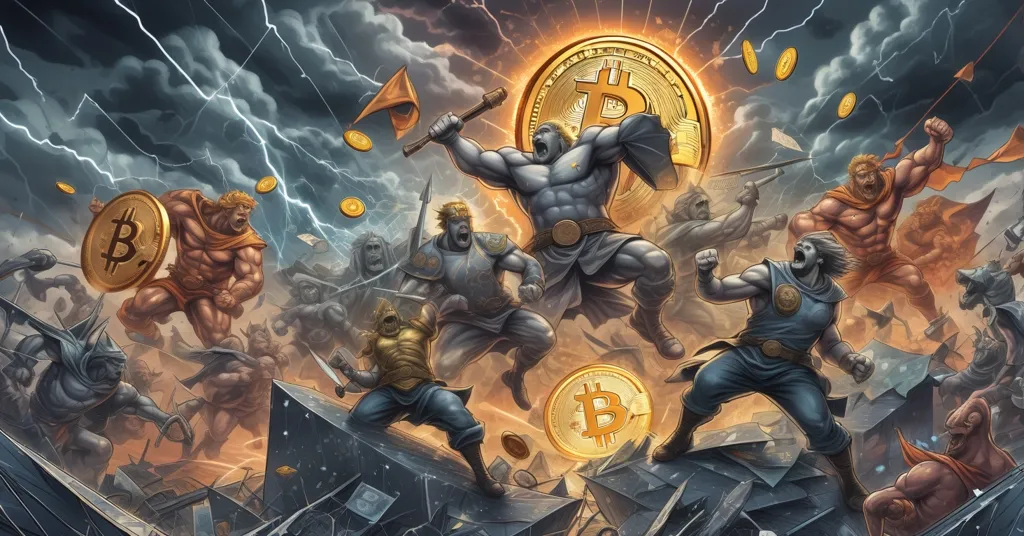Bitcoin Volatility Looms: $15.4B Options Expiry, Trump Crypto Drama, and Blockchain Breakthroughs

Crypto News Update: November 28, 2025 – Bitcoin Volatility, Political Drama, and Blockchain Promise
Brace yourselves, crypto fam—November 28, 2025, is dishing out a wild mix of market tremors, political scandals, and blockchain breakthroughs that could redefine decentralized finance. From a jaw-dropping $15.4 billion Bitcoin and Ethereum options expiry to accusations of White House crypto favoritism, and a tech glitch freezing global futures markets, the stakes couldn’t be higher.
- Options Expiry Chaos: $15.4B in Bitcoin and Ethereum options expire Friday, setting the stage for price turbulence.
- Political Scandal: House Democrats slam Trump administration for allegedly profiting from family crypto ventures.
- Tech Wins and Woes: CME glitch exposes centralized flaws, while Stellar and Chainlink push cross-chain innovation.
Bitcoin & Ethereum Options Expiry: Volatility on the Horizon
Leading the headlines is a monstrous $15.4 billion options expiry for Bitcoin ($13.7B) and Ethereum ($1.7B) set for this Friday. For those new to the space, options are contracts allowing traders to bet on whether an asset’s price will rise (call options) or fall (put options) by a set date. Think of it as a high-stakes deadline where players must cash out or double down, often sparking wild market swings as positions unwind. Bitcoin’s put/call ratio—a measure of bearish versus bullish bets—sits at 0.58, with a “max pain” price of $100K, meaning the level where most traders lose money on their bets, often triggering unexpected moves. Ethereum’s ratio is a neutral 1.0, with max pain at $1,400, well below its current $3,000 trading price. What’s the takeaway? Brace for fakeouts and liquidity hunts as whales and market makers battle it out. Bitcoin, holding steady near $90,800 with a 5% weekly uptick, faces tough resistance at $93K–$96K and $100K–$108K before it can eye new all-time highs. Ethereum, meanwhile, has roared back 17% from recent lows to $3,000, but sharp swings could be imminent. Will we see a breakout, or are we in for another whale-driven rug pull? Bitcoin price volatility in 2025 remains a hot topic, and this expiry could be a defining moment. For the latest updates on market movements, check out current crypto news and price trends.
Market Movers: Whale Activity and Exchange Outflows
Digging into market dynamics, Bitcoin exchange outflows are painting a bullish picture. Over the past 30 days, 47,292 BTC have left centralized platforms, with 14,858 BTC exiting in the last week alone. This signals growing confidence among long-term holders opting for self-custody—storing crypto in personal wallets for control and security rather than trusting exchanges. It often means reduced sell pressure, a potential precursor to price stability or gains. But let’s play devil’s advocate: self-custody isn’t foolproof. Lost private keys or sloppy security can wipe out fortunes faster than a bear market. Still, the trend aligns with Bitcoin’s ethos of sovereignty over centralized middlemen.
On the Ethereum front, whale movements are raising eyebrows. A wallet dormant since 2016 (address: 0x95Bf4d908f60047D689E5fA3c080045b0C3A90e7) transferred 1,300 ETH—worth $3.94 million—to Wintermute, a major crypto market maker. This is part of a larger 6,000 ETH ($18.16 million) shift since November 17, netting the holder a staggering 1,391% profit. Is this profit-taking before a dump, or repositioning for a DeFi play? On-chain data is a cryptic tea leaf at best—don’t read too much into it without context. Ethereum’s price rebound to $3,000 hints at strength, but such whale action reminds us of the speculative undercurrents driving markets. Elsewhere, XRP holds firm above $2.17, showing steady momentum in its own right.
Political Firestorm: Trump’s Crypto Controversy
Shifting gears, the crypto space is getting dragged into a political quagmire. House Democrats have unleashed a blistering report accusing the Trump administration of exploiting White House influence to prop up family-linked crypto ventures, including the controversial WLFI token. Allegations suggest these projects raked in a hefty $800 million from token launches in early 2025, while investigations into potential misconduct were conveniently shelved. This isn’t just drama—it screams conflict of interest louder than a Bitcoin bull run. For context, crypto regulation has long been a battlefield, torn between shielding investors from fraud and nurturing a sector that thrives on breaking the mold. If these claims stick, they could ignite calls for harsher oversight, potentially strangling the freedom and decentralization we fight for. Frankly, if true, this isn’t just politics—it’s a betrayal of the trustless ethos at crypto’s core. Looks like the blockchain isn’t the only thing getting tangled in centralized power plays.
Infrastructure Failures: CME Group Glitch Exposes Risks
On the tech side, a major screw-up at CME Group has laid bare the fragility of centralized systems—a gut punch to those of us pushing for decentralized alternatives. A cooling failure at CyrusOne data centers halted trading across critical futures markets, from commodities and Treasuries to FX and equities. CME Group, a heavyweight in financial exchanges, is pivotal for price discovery, including Bitcoin futures. When such systems crash—especially during a post-Thanksgiving lull with thinner trading—market chaos can erupt, shaking trust in traditional finance. This fiasco is a screaming reminder of why we need blockchain’s distributed resilience. Sure, our tech isn’t flawless; Ethereum gas fees can still gouge wallets, and layer-1 scaling hiccups persist. But single points of failure like this? They’re a disaster begging to repeat. No wonder holders are pulling Bitcoin off exchanges in droves—centralized vulnerabilities are the ultimate red pill.
Blockchain Innovation: Stellar and Chainlink Join Forces
While centralized systems stumble, decentralized projects are stepping up to bridge critical gaps. Stellar, a blockchain built for fast, dirt-cheap transactions, has partnered with Chainlink Labs under the SCALE program to integrate reliable data feeds and turbocharge cross-chain interoperability. Think of this as crafting a universal translator for blockchains, letting them share data and assets without protocol clashes. The goal? Power enterprise-grade tokenization solutions—digitizing real-world assets like real estate, bonds, or supply chain goods into blockchain tokens for liquidity and fractional ownership. Imagine tokenizing a skyscraper so anyone can own a sliver without millions upfront. This could be a linchpin for mainstream adoption, proving blockchain’s worth beyond speculative trading. But let’s not get carried away—regulatory roadblocks and adoption inertia could slow this down. Still, for enterprise blockchain solutions, this is a leap toward relevance.
Real-World Impact: Philippines Targets $60 Billion via Tokenization
Speaking of real-world impact, the Philippines is swinging for the fences with blockchain tech. A recent white paper projects a $60 billion economic boost by 2030 through asset tokenization, backed by a progressive regulatory stance and a thriving fintech scene. Nearly half of government bond holders already own tokenized assets, a testament to early traction. This isn’t just about flashy numbers—it positions the country as a regional pioneer, showing how blockchain can revamp traditional finance, especially in emerging markets craving innovation. Specific moves, like sandbox programs for digital securities and partnerships with global blockchain firms, are fueling this ambition. But here’s the flip side: overblown projections often crash if infrastructure or education lags. Tokenization trends in blockchain adoption sound sexy, but execution is everything. If the Philippines pulls this off, it could be a blueprint for others, cementing digital assets as a global economic force.
Rising Stars or Red Flags? PI Network’s Surge
One market oddity worth a skeptical glance is PI Network, a lesser-known token climbing 11.8% weekly to $1.337, with a hefty $489 million in daily trading volume hinting at institutional interest. But let’s cut the hype—there’s scant clarity on its fundamentals or team. Is it a niche disruptor or just another pump-and-dump dressed in shiny promises? Until proven otherwise, treat unverified buzz with the skepticism it deserves. Our space has enough scammers without us cheerleading question marks. We’re here to drive responsible adoption, not shill every coin that spikes. If PI Network has legs, let’s see the proof—until then, keep your wallet locked.
Bitcoin Maximalism with Altcoin Nuance
Zooming out, let’s anchor on a core belief: Bitcoin remains the king of crypto, the ultimate store of value and decentralized rebellion against fiat tyranny. Its network security, scarcity, and ethos of sovereignty are unmatched, and trends like exchange outflows only reinforce its long-term dominance. Yet, I’ll tip my hat to Ethereum’s unique turf—its smart contract ecosystem powers DeFi and NFTs, filling niches Bitcoin shouldn’t and doesn’t need to touch. Altcoins and other blockchains like Stellar or even XRP carve out their own roles in this financial revolution, often experimenting where Bitcoin’s laser focus on soundness can’t. It’s not a zero-sum game; it’s a messy, beautiful symphony of disruption. Let’s champion decentralization across the board while keeping Bitcoin’s crown polished.
Key Takeaways and Questions
- What drives Bitcoin price swings during options expiry?
A $15.4 billion expiry for Bitcoin and Ethereum can spark turbulence as traders unwind positions, leading to fakeouts and liquidity hunts that jolt prices. - How could Trump crypto allegations impact regulation?
Claims of $800 million profits from family-linked tokens might trigger tighter scrutiny, risking innovation or eroding trust in politically tied projects. - Why does the CME Group glitch matter to crypto markets?
It highlights centralized infrastructure risks; frozen futures markets disrupt price discovery, amplifying chaos and underscoring the need for decentralized systems. - What’s the significance of Stellar and Chainlink’s partnership?
Their focus on cross-chain interoperability boosts secure tokenization for enterprises, potentially accelerating blockchain’s mainstream financial adoption. - Are Bitcoin exchange outflows a bullish sign?
With 47,292 BTC leaving exchanges in 30 days, it suggests long-term holder confidence and reduced sell pressure, often a positive signal. - How game-changing is the Philippines’ $60 billion tokenization goal?
It’s a bold vision for blockchain to transform finance, positioning the country as a leader, though execution risks like infrastructure gaps loom large.
Stepping back, today’s crypto landscape is a battlefield of innovation and instability. Bitcoin and Ethereum navigate choppy waters with grit, while political meddling and tech failures remind us the fight for decentralization is anything but over. Projects like Stellar and nations like the Philippines push boundaries, even as question marks like PI Network test our patience for unproven hype. For every leap forward, there’s a stumble—be it a data center outage or a token launch stinking of insider games. Yet, that’s the raw, untamed spirit of this space: it thrives on shaking things up, flaws and all. As politics and glitches muddy the waters, can crypto’s promise of sovereignty truly outrun the old world’s baggage? Stay sharp, guard your keys, and let’s watch this chaos unfold.



